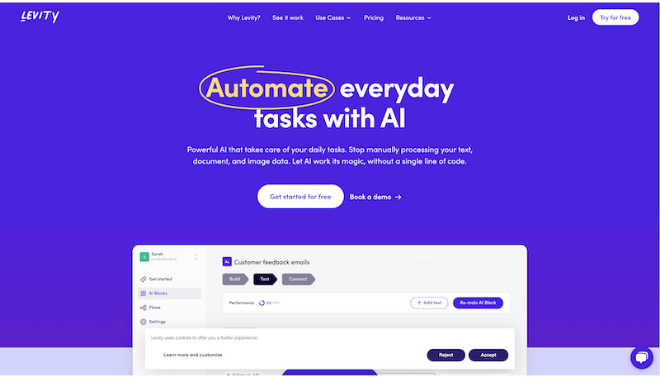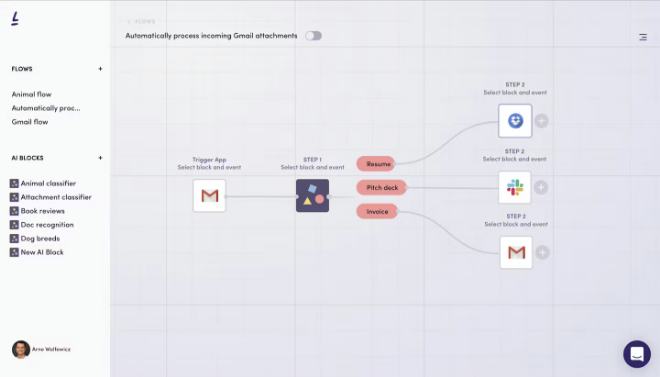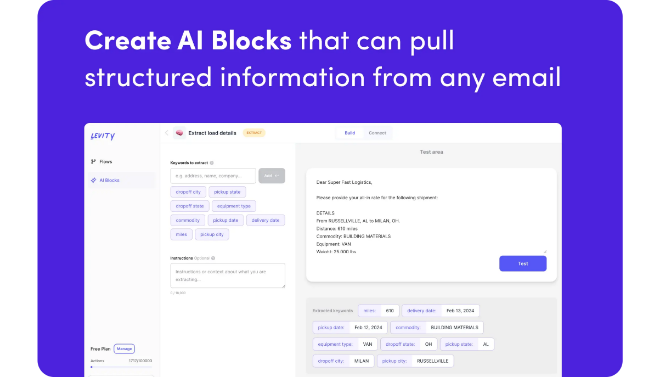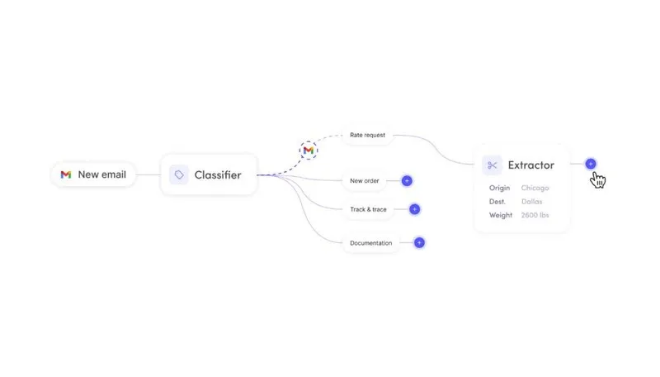Levity AI is a specialized, no-code AI automation platform built to tackle the challenge of unstructured data; emails, documents, images, and text.
Introduction
For many businesses, the biggest drain on time and resources comes from handling unstructured data. Every incoming email, every uploaded document, and every customer comment needs to be manually read, categorized, and processed, a task prone to human error. Levity AI was engineered to automate this “messy” work, providing a platform where AI models are trainable with zero code.
Levity allows users to leverage the power of machine learning, not just for moving data (like traditional automation tools), but for making decisions about it. This approach significantly enhances productivity, reduces operational costs, and minimizes the reliance on IT or data science teams. Levity’s ability to integrate custom-trained AI directly into existing business processes, from Gmail and Slack to various CRM and ERP tools, makes it an essential tool for achieving efficient, scalable operations.
No-Code AI
Unstructured Data
Email Triage
Custom ML
Review
Levity AI is a specialized, no-code AI automation platform built to tackle the challenge of unstructured data—emails, documents, images, and text. Founded by Thilo Huellmann and Gero Keil, Levity empowers non-technical business users (known as “citizen developers”) in departments like Customer Support, Operations, and Marketing to build and deploy custom AI models.
Its primary function is to serve as an intelligent “brain” that enhances existing workflow automation tools (like Zapier or Make). By training Levity’s models on custom, industry-specific data, users can achieve highly personalized automation, such as automatically classifying support tickets, extracting key data from attachments, or routing images based on content. While its usage-based pricing can be a consideration for high-volume tasks, Levity offers extremely fast time-to-value by reducing human error and freeing up knowledge workers from the most time-consuming and manual classification tasks.
Features
Customizable AI Models (No-Code Training)
Allows non-technical users to train custom AI models (classifiers and extractors) using their own business data (e.g., sample emails or documents).
Unstructured Data Classification
Automatically processes and categorizes inputs like emails, PDFs, forms, and images into user-defined categories (e.g., "Billing Inquiry," "Tech Support," "Refund Request").
Data Extraction from Documents
Uses AI to identify and extract specific pieces of information (names, dates, invoice numbers) from unstructured text and documents.
Drag-and-Drop Flow Builder
Features a highly intuitive visual interface to build and manage multi-step workflows, connecting AI classification decisions to actions in other apps.
Extensive App Integration
Connects natively with communication platforms (Gmail, Outlook, Slack) and integrates seamlessly with thousands of apps via platforms like Zapier and Make.
Model Performance Monitoring
Provides analytics and real-time insights to track the AI model's accuracy, performance, and impact on automated workflows.
Best Suited for
Customer Support & Service Teams
To automate email triage, classify incoming tickets instantly, and route them to the correct agent or department.
Operations Managers
Ideal for automating the classification and data entry process for invoices, order forms, and other digital documents.
E-commerce & Retail
To analyze and classify product reviews, social media sentiment, or image uploads in inventory systems.
HR & Compliance Teams
For automatically sorting and classifying incoming applications, resumes, or compliance documents.
Small to Medium-Sized Businesses (SMBs)
Allows smaller teams to utilize powerful AI capabilities without hiring specialized data scientists.
"Citizen Developers" & Automation Specialists
For building sophisticated, custom AI decision steps into broader automation flows.
Strengths
Seamless Ecosystem Integration
True No-Code AI
High ROI/Efficiency
Improves Code Documentation
Weakness
Usage-Based Pricing
Requires Quality Training Data
Getting Started with Levity AI: Step by Step Guide
Getting started with Levity requires training an AI model on a specific business problem.
Step 1: Sign Up and Define Your Problem
Create an account and define the type of unstructured data you want to automate (e.g., “Email Subject Classification”).
Step 2: Create and Train a Custom Model
Upload or connect a dataset of relevant examples (e.g., 100 sample emails). Then, label them according to your desired categories (e.g., “Sales,” “Feedback,” “Spam”).
Step 3: Test and Refine the Model
Run test data through the newly trained model and review its predictions. If accuracy is low, upload more high-quality, diverse training samples and retrain.
Step 4: Build the Workflow in Flow Builder
Use the drag-and-drop Flow Builder to set up the workflow: Trigger (e.g., New Email in Gmail) → AI Step (Levity Classifies Email) → Action (e.g., Send a Slack Notification to the Sales Channel if the category is “Sales”).
Step 5: Deploy and Monitor
Activate the workflow. Monitor the model’s performance and automation volume in the analytics dashboard, refining the training data as needed over time.
Frequently Asked Questions
Q: Does Levity require a code or a data scientist?
A: No. Levity is explicitly a no-code platform. The entire process of training and deploying AI models is done through a user-friendly, drag-and-drop interface using only sample data.
Q: Can Levity be used to automate tasks in my ERP system?
A: Yes, Levity integrates with various platforms, including ERP and TMS (Transportation Management Systems), often through custom or API-based connectors, allowing AI to feed classified data into operational systems.
Q: How many examples do I need to train a model?
A: While there is no fixed number, most classification models start with as few as $50$ to $100$ high-quality, labeled examples per category to achieve useful accuracy.
Pricing
A: While there is no fixed number, most classification models start with as few as $50$ to $100$ high-quality, labeled examples per category to achieve useful accuracy.
Free Tier
$0
Limited actions (e.g., 500) for initial setup and testing.
Startup
$49/month
500 AI actions/month; Access to core features and integrations.
Business
$139/month
5,000 AI actions/month; Higher limits, advanced features, and analytics.
Alternatives
Make (formerly Integromat)
A powerful, visual no-code orchestration tool that provides the "pipes" for building complex, multi-step workflows, which Levity often integrates into.
Zapier
The market leader in general-purpose workflow automation (reactive triggers), with a broad ecosystem, but lacks Levity's dedicated, custom-trainable AI core for unstructured data.
Bitskout
Another AI automation tool that focuses on extracting data and insights from documents (like invoices and contracts) and injecting them into project management tools.
Share it on social media:
Questions and answers of the customers
There are no questions yet. Be the first to ask a question about this product.
















Leave feedback about this